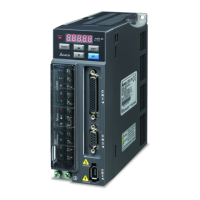Chapter 2 Devices
2-49
Reset
When the instruction RST is executed, the current value is
cleared to zero, and the contact is reset of OFF.
After the scan is complete, the contact acts.
The function of the counter:
Each time the input switches from OFF to ON, the value of the counter increases by one increment.
When the value of the counter matches the setting value, the output coil is ON. Users can use either
the decimal constant or the value in the data register as the setting value.
The 16-bit counter:
1. Setting range: 0~32,767 (The setting values 0 and 1 mean the same thing in that the output
contact is ON when the counter counts for the first time.)
2. For the general-purpose counter, the current value of the counter is cleared when there is a
power cut. If the counter is the latched one, the current value of the counter and the state of
the contact before the power cut will be retained. The latched counter counts from the current
value when the power supply is restored.
3. If users use the instruction MOV or ISPSoft to transmit a value bigger than the setting value to
the current value register C0, the contact of the counter C0 will be ON and the current value
will become the same as the setting value next time ×0.1 is switched from OFF to ON.
4. Users can use either the constant or the value in the register as the setting value of the
counter.
5. The setting value of the counter can be a positive or a negative. If the counter counts up from
32,767, the next current value becomes -32,768.
Example:
1. When X0.0 is ON, the instruction RST is executed, the current value of the counter C0 is
cleared to zero, and the output contact is reset to OFF.
2. If ×0.1 is switched from OFF to ON, the counter will count up, i.e. the current value will
increase by one.
3. When the current value of the counter C0 matches the setting value 5, the contact of C0 is ON.
Even if ×0.1 is still triggered, C0 does not accept the trigger signal, and the current value
remains 5.

